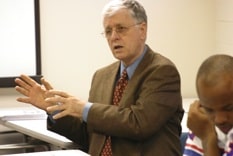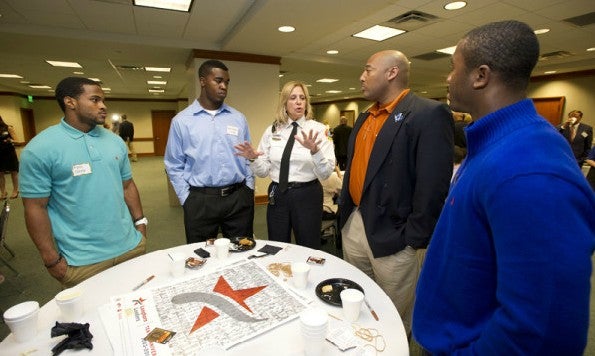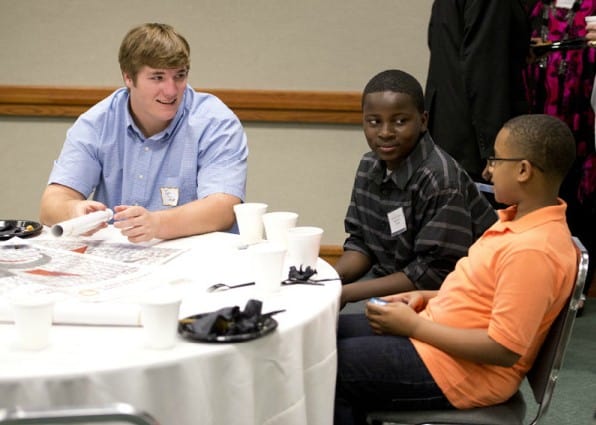University of Texas at Austin athletes thrill Longhorn fans from fall through spring, year in and year out.
For the past 10 years, many of the athletes, including those in the headlines and highlight reels, have worked in a quieter way to help at-risk middle school students in Austin stay out of trouble and stay in school.
As members of the Longhorn Leaders program, the student-athletes and other UT Austin students engage with middle schoolers about the tough choices they face as they move from childhood to adolescence. UT students deliver the same message, filtered through their own experiences: stay in school, stay away from drugs, don’t join gangs and avoid pregnancy.

“We know from the (scientific) literature that if you can get the kid through the ninth grade, they’re probably going to finish high school,” said Michael Lauderdale, the Clara Pope Willoughby Centennial Professor in Criminal Justice at the School of Social Work, who started and runs the program. “The critical thing is that transition from grade school to middle school and then to high school.”
As the program marks its 10th year, it has received commendations from the Texas Legislature, the Austin Crime Commission and the Austin City Council. This past April the program was lauded at a dinner with a guest list that included city and school officials, community leaders, UT Austin coaches and others (watch a video of the celebrations from TexasSports.com).
The Austin Crime Commission supports the program along with the Motorola Solutions Foundation and University Federal Credit Union.
Where some programs might try to separate sports and academics, Longhorn Leaders embraces the combination. It gets the attention of the middle school kids.
“If I can get a student who is on television a lot, representing the university, the kids are going to know who that is,” Lauderdale said. “On this campus that’s largely football players. Then basketball players, men and women.”

The program has had plenty of football and basketball players from Vince Young and Kevin Durant, Cat Osterman from softball player and track stars such as Sanya Richards-Ross as well as other sports including women’s basketball, soccer and volleyball players. Non-athlete students also play an important role in the program, particularly social work students and others focusing on community and neighborhood issues.
The program has had an impact of the middle schoolers, said Robert Mendoza, assistant principal at Kealing Middle School, where the program has been conducted for the past few years.
“We see major changes in attitude and behavior,” he said. He cited an eighth-grade girl who credited the program with calming her habit of fighting and troublemaking. This summer she’s working as an intern in the office of Austin City Council Member Mike Martinez. And she has her sights set on college and law school.
The program was borne out of a request that the Austin Crime Commission made to Lauderdale in the 1990s, when dropout rates and gang activity were skyrocketing. Lauderdale, whose expertise includes organizational behavior ranging from military units to corporations to gangs, has worked with criminal justice authorities for decades. When the university went looking for a new police chief earlier this year, Lauderdale chaired the search committee.
Rather than ask students to volunteer their valuable time, he developed a class around the idea. The college students learn about social work theories on at-risk youth, the causes of at-risk behaviors and how to deal with the kids.
“They really learn in pretty good fashion how you profile a kid, what are the at-risk factors: poverty, learning disabilities, lack of adults figure in the household, a parent who is in prison,” Lauderdale said. “We try to ground them in substantial theory.”
The students prepare presentations they then make to the middle school kids. The presentations go over the challenges the college students have had in their lives and how they’ve overcome them. “They talk to the students about how you avoid being in gangs, how you make decisions on dating, what’s appropriate activity, what drugs are and how to avoid drugs and how you set goals and achieve the goals,” Lauderdale said.
The two groups of students meet in a classroom at Kealing. There usually are 20-30 UT Austin students and as many as 60 Kealing students. The college students, at first, overwhelm the Kealing students, Lauderdale said. But by about the third meeting, they open up and become more comfortable talking about the problems they’re struggling with.

Former Texas football player Quan Cosby, in comments to TexasSports.com, said that he recognized the opportunity that the student-athletes have to connect with the middle school students.
“I’ve heard those stories,” said Cosby, a School of Social Work graduate. “They had that one guy, that one coach, that one friend or mentor that really said something right or motivated them to `get their mind right’ as we say. [They] get focused to reach a goal and get to college and be on the right track.”
Lauderdale said the class helps keep Kealing students on track. He said their school attendance improves, their behavior improves and they become more involved in extracurricular activities.
He is starting to gather data to measure the program’s long-term impact on the middle school students. Lauderdale said he and others involved in the program are trying to determine how it can be expanded to more schools and even other cities.
And the program works both ways, said Mendoza, the Kealing vice principal. “The UT students become stronger leaders,” he said. “Now the UT students are role models and they have to act a certain way, people are looking up to them.”


